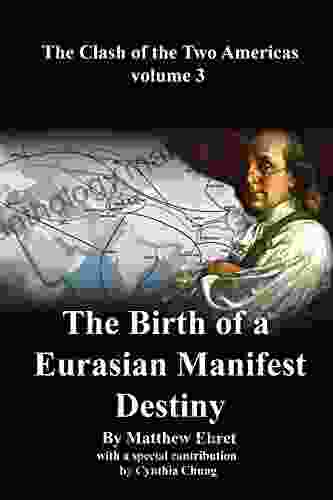The Birth of Eurasian Manifest Destiny: A Comprehensive Exploration of a Geopolitical Concept

4.4 out of 5
| Language | : | English |
| File size | : | 24775 KB |
| Text-to-Speech | : | Enabled |
| Screen Reader | : | Supported |
| Enhanced typesetting | : | Enabled |
| Print length | : | 530 pages |
| Lending | : | Enabled |
The concept of Eurasian Manifest Destiny is a geopolitical theory that has gained significant traction in recent years, particularly in the context of Russia's and China's growing influence in Eurasia. This article aims to provide a comprehensive analysis of the origins, evolution, and implications of Eurasian Manifest Destiny, examining its historical roots, geopolitical underpinnings, and contemporary manifestations. By delving into the ideas of prominent geopolitical thinkers and analyzing key events that have shaped the Eurasian landscape, we will gain a deeper understanding of this complex and multifaceted concept.
Origins and Historical Context
The origins of Eurasian Manifest Destiny can be traced back to the geopolitical theories of Sir Halford Mackinder, specifically his Heartland Theory. Mackinder argued that whoever controls Eastern Europe and Central Asia, known as the "Heartland," would have the potential to dominate the "World Island," encompassing Eurasia and Africa. This theory emphasized the strategic importance of land power and the vulnerability of sea power to interior lines of communication.
In the 20th century, geopolitical thinkers such as Nicholas Spykman and Zbigniew Brzezinski expanded on Mackinder's ideas, developing the concept of the "Rimland" - the coastal areas surrounding the Heartland. Spykman argued that the Rimland was the key to controlling Eurasia and preventing any single power from establishing hegemony over the continent. Brzezinski, in turn, emphasized the importance of the "Grand Chessboard," encompassing Eurasia and its surrounding regions, as the primary arena for global geopolitical competition.
The Rise of Russia and China
The rise of Russia and China as major global powers in recent decades has reinvigorated interest in the concept of Eurasian Manifest Destiny. Russia, with its vast territorial expanse and its historical legacy as a Eurasian power, has sought to reassert its influence in its former sphere of influence, particularly in Central Asia and Eastern Europe. China, on the other hand, has adopted a more assertive foreign policy and has embarked on a massive infrastructure project known as the Belt and Road Initiative, which aims to connect China to Europe, Asia, and Africa.
The growing presence of Russia and China in Eurasia has raised concerns among some Western policymakers and geopolitical analysts. They argue that these countries' actions represent an attempt to create a Eurasian sphere of influence that would challenge the existing global order dominated by the United States. This perception has led to the term "Eurasian Manifest Destiny" being applied to the perceived ambitions of Russia and China to establish their dominance over Eurasia.
Contemporary Manifestations
There are several contemporary manifestations of Eurasian Manifest Destiny. One is the development of the Eurasian Economic Union (EAEU),a regional economic bloc led by Russia that includes Armenia, Belarus, Kazakhstan, and Kyrgyzstan. The EAEU aims to create a common market and promote economic integration among its member states. Another manifestation is the Shanghai Cooperation Organization (SCO),a security and economic bloc that includes China, Russia, India, Pakistan, Kazakhstan, Kyrgyzstan, Tajikistan, and Uzbekistan. The SCO is seen as a counterweight to Western influence in Central Asia and as a platform for promoting regional cooperation.
Russia's annexation of Crimea in 2014 and its ongoing support for separatists in eastern Ukraine are also seen by some as manifestations of Eurasian Manifest Destiny. These actions have led to increased tensions between Russia and the West and have raised concerns about Russia's intentions in the region. China's construction of artificial islands in the South China Sea and its increasing military presence in the region have also been interpreted as attempts to assert its dominance in Eurasia.
Implications for Global Geopolitics
The implications of Eurasian Manifest Destiny for global geopolitics are complex and far-reaching. If Russia and China succeed in establishing a Eurasian sphere of influence, it would represent a major shift in the existing global order. The United States, which has been the dominant global power since the end of World War II, would face a significant challenge to its influence and its ability to maintain its global leadership.
A Eurasian sphere of influence could also lead to increased competition and conflict between major powers. Russia and China, as well as the United States, have competing interests in Eurasia, and their ambitions could clash over issues such as energy, security, and access to resources. This could lead to a more volatile and unstable world order.
The concept of Eurasian Manifest Destiny is a complex and multifaceted geopolitical theory that has significant implications for global affairs. Its origins can be traced back to the geopolitical theories of the 20th century, and it has been revived in recent years due to the rise of Russia and China as major global powers. While Eurasian Manifest Destiny is not without its critics, it remains an important concept to understand in order to grasp the evolving geopolitical dynamics of Eurasia and its implications for the global order.
4.4 out of 5
| Language | : | English |
| File size | : | 24775 KB |
| Text-to-Speech | : | Enabled |
| Screen Reader | : | Supported |
| Enhanced typesetting | : | Enabled |
| Print length | : | 530 pages |
| Lending | : | Enabled |
Do you want to contribute by writing guest posts on this blog?
Please contact us and send us a resume of previous articles that you have written.
 Top Book
Top Book Novel
Novel Fiction
Fiction Nonfiction
Nonfiction Literature
Literature Paperback
Paperback Hardcover
Hardcover E-book
E-book Audiobook
Audiobook Bestseller
Bestseller Classic
Classic Mystery
Mystery Thriller
Thriller Romance
Romance Fantasy
Fantasy Science Fiction
Science Fiction Biography
Biography Memoir
Memoir Autobiography
Autobiography Poetry
Poetry Drama
Drama Historical Fiction
Historical Fiction Self-help
Self-help Young Adult
Young Adult Childrens Books
Childrens Books Graphic Novel
Graphic Novel Anthology
Anthology Series
Series Encyclopedia
Encyclopedia Reference
Reference Guidebook
Guidebook Textbook
Textbook Workbook
Workbook Journal
Journal Diary
Diary Manuscript
Manuscript Folio
Folio Pulp Fiction
Pulp Fiction Short Stories
Short Stories Fairy Tales
Fairy Tales Fables
Fables Mythology
Mythology Philosophy
Philosophy Religion
Religion Spirituality
Spirituality Essays
Essays Critique
Critique Commentary
Commentary Glossary
Glossary Bibliography
Bibliography Index
Index Table of Contents
Table of Contents Preface
Preface Introduction
Introduction Foreword
Foreword Afterword
Afterword Appendices
Appendices Annotations
Annotations Footnotes
Footnotes Epilogue
Epilogue Prologue
Prologue Carla Bartolucci
Carla Bartolucci Joseph Sarosy
Joseph Sarosy April Laugh
April Laugh Arndt Sorge
Arndt Sorge Bernard Knight
Bernard Knight William Kotzwinkle
William Kotzwinkle Rebecca Roanhorse
Rebecca Roanhorse Cindy Stringer Wismer
Cindy Stringer Wismer Erik Ringmar
Erik Ringmar Donna Maher
Donna Maher Carla A Norde
Carla A Norde Erik Shonstrom
Erik Shonstrom P M Forni
P M Forni Carol Ann Duffy
Carol Ann Duffy Azra Raza
Azra Raza Jennifer Lynn Barnes
Jennifer Lynn Barnes Brad Wetzler
Brad Wetzler Vinay Singh
Vinay Singh Tito Rajarshi Mukhopadhyay
Tito Rajarshi Mukhopadhyay Kris Bordessa
Kris Bordessa
Light bulbAdvertise smarter! Our strategic ad space ensures maximum exposure. Reserve your spot today!

 Derrick HughesDive into the Depths: A Comprehensive Guide to King Shark, the Apex Predator...
Derrick HughesDive into the Depths: A Comprehensive Guide to King Shark, the Apex Predator...
 George R.R. MartinFour Week Plan to Reprogram Your Microbiome, Restore Health, and Lose Weight
George R.R. MartinFour Week Plan to Reprogram Your Microbiome, Restore Health, and Lose Weight Walter SimmonsFollow ·4.6k
Walter SimmonsFollow ·4.6k Bryan GrayFollow ·15.3k
Bryan GrayFollow ·15.3k Aleksandr PushkinFollow ·13.7k
Aleksandr PushkinFollow ·13.7k Demetrius CarterFollow ·8.7k
Demetrius CarterFollow ·8.7k Gage HayesFollow ·7.9k
Gage HayesFollow ·7.9k Eddie PowellFollow ·7.8k
Eddie PowellFollow ·7.8k Eddie BellFollow ·8k
Eddie BellFollow ·8k Fletcher MitchellFollow ·6.5k
Fletcher MitchellFollow ·6.5k

 Vernon Blair
Vernon BlairThe Woman I Met in My Dream: An Unforgettable Night of...
As the veil of night...

 Carlos Fuentes
Carlos FuentesThe Ultimate Guide to Healthy Eating for Toddlers: Meal...
As a parent of a...

 Peter Carter
Peter CarterInside My Autistic Mind: A Journey of Self-Discovery and...
Autism spectrum disorder (ASD) is a...

 Isaac Asimov
Isaac AsimovA Journey Through Jane Austen's Literary Masterpieces:...
Jane Austen, the renowned English...

 Hank Mitchell
Hank MitchellAdvancements in Textiles: Science and Technology by...
The textile...

 Troy Simmons
Troy SimmonsRecovery Road: An Odyssey of Hope and Redemption by...
Recovery Road is a...
4.4 out of 5
| Language | : | English |
| File size | : | 24775 KB |
| Text-to-Speech | : | Enabled |
| Screen Reader | : | Supported |
| Enhanced typesetting | : | Enabled |
| Print length | : | 530 pages |
| Lending | : | Enabled |








